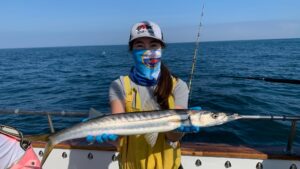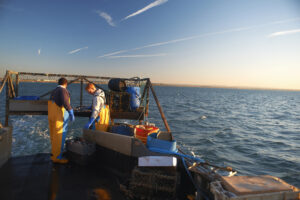MPA Monitoring Series: Ask the Researcher, Part 3: California Collaborative Fisheries Research Program and Commercial & CPFV Fisheries
In the 5th and 6th “Ask the Researcher” MPA monitoring series webinars held in July, we discussed the California Collaborative Fisheries Research Program (CCFRP) and Human Dimensions: Commercial & Commercial Passenger Fishing Vessel (CPFV) Fishing. To learn more about this exciting summer series, and the previous webinars, check out: Ask the Researcher, Part 1: Kelp and Rocky Intertidal Ecosystems and Part 2: Ocean Observing Systems and Sandy Beach Ecosystems.
California Collaborative Fisheries Research Program (CCFRP)

Photo: Pacific barracuda courtesy of CCFRP
July’s webinars began with a conversation about the California Collaborative Fisheries Research Program (PDF), led by Dr. Scott Hamilton from the Moss Landing Marine Laboratories. Dr. Hamilton introduced the purpose and conception of the CCFRP, which is a community-based and fisheries-independent research program for MPA monitoring and fisheries management. The CCFRP has been a partnership between the fishing community, academic scientists, and resource management since its inception in 2007, aimed to increase scientific knowledge about the effects of MPA implementation.
From 2007 to 2021, CCFRP studied MPA sites and paired reference sites in Central California, expanding to statewide sampling in 2017. The program has sampled over 690 days at sea in 31 sportfishing boats, with the contributions of 53 captains and 1800+ volunteer anglers. Anglers and scientists worked together to record crucial MPA and fisheries data, including species abundance and biomass, fish length, fish condition, and tag-recapture information, which is accessible through a downloadable dataset.
Dr. Hamilton presented four main outcomes of CCFRP’s work:
- Across California, fish are larger and more abundant inside MPAs compared to reference areas open to fishing.
- Fish abundance and biomass increased more rapidly inside MPAs on the Central Coast over the course of 14 years.
- MPAs appeared more resilient to climate events, such as the 2014-2015 marine heatwave. Fish diversity initially decreased both inside and out of MPAs, but recovered more quickly in MPAs than in reference sites.
- Anglers that participated in the CCFRP program developed more positive opinions toward MPAs. Additionally, anglers reported that they caught more fish, bigger fish, and a higher diversity of fishes inside MPAs on CCFRP sampling trips, which likely contributed to increasingly positive opinions about MPAs.
To hear more detailed data analysis observations, and patterns, watch the CCFRP webinar recording.
Human Dimensions: Commercial & Commercial Passenger Fishing Vessel (CPFV) Fishing

Photo: Peter Muller / Getty Images
The Human Dimensions: Commercial & CPFV Fishing (PDF) webinar was led by Jon Bonkoski from Ecotrust with support from Rachelle Fisher of Strategic Earth. In collaboration with partners from Cal Poly Humboldt and Strategic Earth, this project aimed to understand the socioeconomic outcomes of MPAs for commercial and commercial passenger fishing vessel fisheries in California.
Bonkoski began by introducing the importance of tracking the equitable and economic perspective in addition to traditional ecological monitoring. Management of MPAs is, by proxy, also management of the people that co-exist and rely on the ocean for their livelihoods. The project team developed methods to address three core components:
- Engagement with fishermen across 18 major California port groups, managers, researchers, and other invested parties;
- Design and implementation of port-based and/or regional focus groups with members of California’s commercial and CPFV fishing communities related to community well-being and outcomes from the MPA network; and
- Spatial data modeling to explore spatial use of the ocean by commercial fisheries in relation to the MPA network
The project team gathered robust qualitative and quantitative data on port community well-being, attitudes, and perceptions of MPA impacts from all major commercial fishing ports using focus groups that took place from 2020-2021 with the efforts of 85 commercial fishing community participants and 20 CPFV community participants.
The results of this study culminated in the development of the MPA Human Uses website, a compilation of data, resources, and key findings from the project. Bonkoski shared a few key summary findings of this study:
- The perceived community well-being varied across the state. Commercial fishing participants rated community social relationships, current marine resource health, and job satisfaction as overall positives. Port infrastructure, harvestable resources access, and future resource health perceptions were below neutral.
- Using a modeled dataset, proportion of catch in areas adjacent to MPAs increased from pre-MPA implementation years compared to post-implementation.
- Focus group responses indicated commercial fishing participants across California were overall both dissatisfied with and had experienced negative effects from the MPA Network.
- CPFV participants were dissatisfied with MPA management, monitoring, and enforcement, specifically emphasizing their perceptions of poor communication about the MPA Program.
For more detailed information, watch the Commercial & CPFV Fishing webinar recording.
Further Exploration
You can read the full MPA monitoring reports for all of the MPA research projects on California Sea Grant’s website. Short on time? Check out the two-page snapshot summary reports available in both English and Spanish. All of the baseline and long-term monitoring data is available on the new California MPA data portal.
The next Ask the Researcher webinar will be on estuary ecosystems on August 9, 2022 from 12:00 p.m. to 1:00 p.m. You won’t want to miss it! Join the webinar by Zoom.
View all of the post-webinar summaries on our blog or watch the webinar recordings on our YouTube channel

